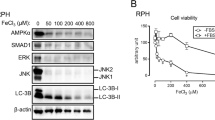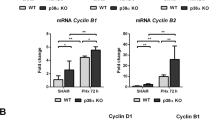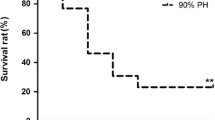Abstract
Although iron overload is implicated in hepatocarcinogenesis, the precise mechanism was not known yet. In the present study, we investigated the effect of iron overload upon the induction of hepatocyte proliferation after 70 % partial hepatectomy (PH) in rats fed with rat chow with 3 % carbonyl iron for 3 months. In normal-diet rats, the increase in Ki-67 labeling index (LI) commenced at 24 h post-PH and the LIs of proliferating cell nuclear antigen (PCNA) incorporated 5-bromo-2′-deoxyuridine (BrdU) and phospho-histone H3 reached maximum values at 36 and 48 h after PH, respectively. In iron-overload rats, the above parameters occurred 12 h earlier compared to that of normal-diet rats, shortening the G0–G1 transition. Interestingly, nuclear staining for metallothionein (MT), which is essential for hepatocyte proliferation, was noted even at 0 h in iron-overload rats, while MT expression occurred at 6 h in the normal rats. Moreover, nuclear factor kappa B (NF-κB) expression, which is an essential early event leading to liver regeneration, was detected in Kupffer cells at 0 h in iron-overload rats. These results may indicate that overloaded iron, maybe through the induction of MT and NF-κB, may keep liver as a state ready to regenerate in response to PH, by bypassing signal transduction cascades involved in the initiation of liver regeneration.









Similar content being viewed by others
Change history
24 March 2020
The figure shown below is the correct version. We apologize for the mistake.
24 March 2020
The figure shown below is the correct version. We apologize for the mistake.
References
Abo T, Nagayasu T, Hishikawa Y, Tagawa T, Nanashima A, Yamayoshi T, Matsumoto K et al (2010) Expression of keratinocyte growth factor and its receptor in rat tracheal cartilage: possible involvement in wound healing of the damaged cartilage. Acta Histochem Cytochem 43:89–98
Ashizawa M, Miyazaki M, Abe K, Furusu A, Isomoto H, Harada T, Ozono Y et al (2003) Detection of nuclear factor-κB in IgA nephropathy using southwestern histochemistry. Am J Kidney Dis 42:76–86
Bacon BR, Britton RS (1990) The pathology of hepatic iron overload: a free radical-mediated process? Hepatology 11:127–137
Bader A, Pavlica S, Deiwick A, Lotkova H, Kucera O, Darsow K, Bartel S et al (2011) Proteomic analysis to display the effect of low doses of erythropoietin on rat liver regeneration. Life Sci 89:827–833
Brown KE, Broadhurst KA, Mathahs MM, Weydert J (2007) Differential expression of stress-inducible proteins in chronic hepatic iron overload. Toxicol Appl Pharmacol 223:180–186
Brunet S, Thibault L, Delvin E, Yotov W, Bendayan M, Levy E (1999) Dietary iron overload and induced lipid peroxidation are associated with impaired plasma lipid transport and hepatic sterol metabolism in rats. Hepatology 29:1809–1817
Bucher NL, Swaffield MN, Ditroia JF (1964) The influence of age upon the incorporation of thymidine-2-C14 into the DNA of regenerating rat liver. Cancer Res 24:509–512
Cherian MG, Apostolova MD (2000) Nuclear localization of metallothionein during cell proliferation and differentiation. Cell Mol Biol 46:347–356
Cherian MG, Kang YJ (2006) Metallothionein and liver cell regeneration. Exp Biol Med 231:138–144
Cherian MG, Jayasurya A, Bay BH (2003) Metallothioneins in human tumors and potential roles in carcinogenesis. Mutat Res 533:201–209
Cornejo P, Varela P, Videla LA, Fernández V (2005) Chronic iron overload enhances inducible nitric oxide synthase expression in rat liver. Nitric Oxide 13:54–61
Cressman DE, Greenbaum LE, Haber BA, Taub R (1994) Rapid activation of post-hepatectomy factor/nuclear factor κB in hepatocytes, a primary response in the regenerating liver. J Biol Chem 269:30429–30435
Di Bisceglie AM (1997) Hepatitis C and hepatocellular carcinoma. Hepatology 26:34S–38S
Fausto N, Campbell JS, Riehle KJ (2006) Liver regeneration. Hepatology 43:S45–S53
Gavrieli Y, Sherman Y, Ben-Sasson SA (1992) Identification of programmed cell death in situ via specific labeling of nuclear DNA fragmentation. J Cell Biol 119:493–501
Hentze MW, Muckenthaler MU, Andrews NC (2004) Balancing acts: molecular control of mammalian iron metabolism. Cell 117:285–297
Higgins GM, Anderson RM (1931) Experimental pathology of the liver. 1. Restoration of the liver of the white rat following partial surgical removal. Arch Pathol 12:186–202
Hishikawa Y, Koji T, Dhar DK, Kinugasa S, Yamaguchi M, Nagasue N (1999) Metallothionein expression correlates with metastatic and proliferative potential in squamous cell carcinoma of the oesophagus. Br J Cancer 81:712–720
Isomoto H, Miyazaki M, Mizuta Y, Takeshima F, Murase K, Inoue K, Yamasaki K et al (2000) Expression of nuclear factor-κB in Helicobacter pylori-infected gastric mucosa detected with southwestern histochemistry. Scand J Gastroenterol 3:247–254
Kagi JHR, Vallee BL (1961) Metallothionein: a cadmium and zinc-containing protein from equine renal cortex. J Biol Chem 236:2435–2442
Kato J, Kobune M, Nakamura T, Kuroiwa G, Takada K, Takimoto R, Sato Y et al (2001) Normalization of elevated hepatic 8-hydroxy-2′-deoxyguanosine levels in chronic hepatitis C patients by phlebotomy and low iron diet. Cancer Res 61:8697–8702
Kirillova I, Chaisson M, Fausto N (1999) Tumor necrosis factor induces DNA replication in hepatic cells through nuclear factor κB activation. Cell Growth Differ 10:819–828
Knittel T, Mehde M, Grundmann A, Saide B, Scharf J-G, Ramadori G (2000) Expression of matrix metalloproteinases and their inhibitors during hepatic tissue repair in the rat. Histochem Cell Biol 113:443–453
Koji T, Nakane PK, Murakoshi M, Watanabe K, Terayama H (1988) Cell density dependent morphological changes in adult rat hepatocytes during primary culture. Cell Biochem Funct 6:237–243
Koji T, Komuta K, Nozawa M, Yamada S, Nakane PK (1994) Localization of cyclic adenosine 3′,5′-monophosphate-responsive element (CRE)-binding proteins by southwestern histochemistry. J Histochem Cytochem 42:1399–1405
Koji T, Kondo S, Hishikawa Y, An S, Sato Y (2008) In situ detection of methylated DNA by histo endonuclease-linked detection of methylated DNA sites: a new principle of analysis of DNA methylation. Histochem Cell Biol 130:917–925
Kojima N, Young CR, Bates GW (1982) Failure of metallothionein to bind iron or act as an iron mobilizing agent. Biochim Biophys Acta 716:273–275
Kowdley KV (2004) Iron, hemochromatosis, and hepatocellular carcinoma. Gastroenterology 127:S79–S86
Michalopoulos GK (2007) Liver regeneration. J Cell Physiol 213:286–300
Miyata T, Minai Y, Haga M (2008) Impaired growth of small intestinal epithelium by adrenalectomy in weaning rats. Acta Histochem Cytochem 41:83–88
Nakajima H, Mizuta N, Fujiwara I, Sakaguchi K, Ogata H, Magae J, Yagita H et al (2008) Blockade of the Fas/Fas ligand interaction suppresses hepatocyte apoptosis in ischemia-reperfusion rat liver. Apoptosis 13:1013–1021
Nejak-Bowen KN, Thompson MD, Singh S, Bowen WC Jr, Dar MJ, Khillan J, Dai C et al (2010) Accelerated liver regeneration and hepatocarcinogenesis in mice overexpressing serine-45 mutant β-catenin. Hepatology 51:1603–1613
Nick H, Allegrini PR, Fozard L, Junker U, Rojkjaer L, Salie R, Niederkofler V et al (2009) Deferasirox reduces iron overload in a murine model of juvenile hemochromatosis. Exp Biol Med 234:492–503
Oliver JR, Mara TW, Cherian MG (2005) Impaired hepatic regeneration in metallothionein-I/II knockout mice after partial hepatectomy. Exp Biol Med 230:61–67
Park CH, Bacon BR, Brittenham GM, Tavill AS (1987) Pathology of dietary carbonyl iron overload in rats. Lab Invest 57:555–563
Perls M (1867) Nachweis von Eisenoxyd in gewissen Pigmenten. Virchows Arch 39:42–48
Pietrangelo A, Rocchi E, Schiaffonati L, Ventura E, Cairo G (1990) Liver gene expression during chronic dietary iron overload in rats. Hepatology 11:798–804
Pigeon C, Ilyin G, Courselaud B, Leroyer P, Turlin B, Brissot P, Loréal O (2001) A new mouse liver-specific gene, encoding a protein homologous to human antimicrobial peptide hepcidin, is overexpressed during iron overload. J Biol Chem 276:7811–7819
Plümpe J, Malek NP, Bock CT, Rakemann T, Manns MP, Trautwein C (2000) NF-κB determines between apoptosis and proliferation in hepatocytes during liver regeneration. Am J Physiol Gastrointest Liver Physiol 278:G173–G183
Sheikh N, Batusic DS, Dudas J, Tron K, Neubauer K, Salie B, Ramadori G (2006) Hepcidin and hemojuvelin gene expression in rat liver damage: in vivo and in vitro studies. Am J Physiol Gastrointest Liver Physiol 291:G482–G490
Shin T, Kuboki S, Lentsch AB (2008) Roles of nuclear factor-κB in postischemic liver. Hepatol Res 38:429–440
Shukuwa K, Izumi S, Hishikawa Y, Ejima K, Inoue S, Muramatsu M, Ouchi Y et al (2006) Diethylstilbestrol increases the density of prolactin cells in male mouse pituitary by inducing proliferation of prolactin cells and transdifferentiation of gonadotropic cells. Histochem Cell Biol 126:111–123
Soe K, Hishikawa Y, Fukuzawa Y, Win N, Yin KS, Win KM, Myint AA et al (2007) Possible correlation between iron deposition and enhanced proliferating activity in hepatitis C virus-positive hepatocellular carcinoma in Myanmar (Burma). J Gastroenterol 42:225–235
Teoh N, Dela PA, Farrell G (2002) Hepatic ischemic preconditioning in mice is associated with activation of NF-κB, p38 kinase, and cell cycle entry. Hepatology 36:94–102
Tohyama C, Suzuki JS, Hemelraad J, Nishimura N, Nishimura H (1993) Induction of metallothionein and its localization in the nucleus of rat hepatocytes after partial hepatectomy. Hepatology 18:1193–1201
Turlin B, Juguet F, Moirand R, Le Quilleuc D, Loréal O, Campion JP, Launois B et al (1995) Increased liver iron stores in patients with hepatocellular carcinoma developed on a noncirrhotic liver. Hepatology 22:446–450
Wang RA, Nakane PK, Koji T (1998) Autonomous cell death of mouse male germ cells during fetal and postnatal period. Biol Reprod 58:1250–1256
Williams LM, Cunningham H, Ghaffar A, Riddoch GI, Bremner I (1989) Metallothionein immunoreactivity in the liver and kidney of copper injected rats. Toxicology 55:307–316
Wullaert A, van Loo G, Heyninck K, Beyaert R (2007) Hepatic tumor necrosis factor signaling and nuclear factor-κB: effects on liver homeostasis and beyond. Endocr Rev 28:365–386
Xiong S, She H, Sung CK, Tsukamoto H (2003) Iron-dependent activation of NF-κB in Kupffer cells: a priming mechanism for alcoholic liver disease. Alcohol 30:107–113
Yano M, Hayashi H, Yoshioka K, Khogo Y, Saito H, Niitsu Y, Kato J et al (2004) A significant reduction in serum alanine aminotransferase levels after 3-month iron reduction therapy for chronic hepatitis C: a multicenter, prospective, randomized, controlled trial in Japan. J Gastroenterol 39:570–574
Acknowledgments
This work was supported in part by a Grant-in-Aid for Scientific Research from the Japanese Ministry for Education, Culture, Sports, Science and Technology (Nos. 18390060 and 19406005 to T. Koji).
Author information
Authors and Affiliations
Corresponding author
Rights and permissions
About this article
Cite this article
An, S., Soe, K., Akamatsu, M. et al. Accelerated proliferation of hepatocytes in rats with iron overload after partial hepatectomy. Histochem Cell Biol 138, 773–786 (2012). https://doi.org/10.1007/s00418-012-0994-4
Accepted:
Published:
Issue Date:
DOI: https://doi.org/10.1007/s00418-012-0994-4




